|
Cell tower climbers surface as having the most dangerous job in America
January 30, 2006 - Based upon the latest national census of fatal occupational injuries from the Department of Labor's Bureau of Labor Statistics, workers who are required to climb cell towers and other communications structures throughout the country have been identified as having the most dangerous job in America. 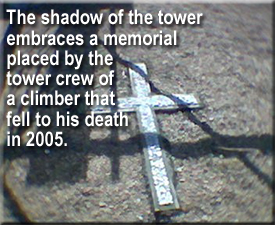
In previous years, inaccurate Occupational Health and Safety Administration coding and an unknown total of tower climbers prevented the tower erection and maintenance industry from revealing the most fatalities per 100,000 workers.
Although tower climbers are one of the smallest specialized construction groups with approximately 8,700 employees, they had ten fatalities from workers falling from a tower in 2004, representing 115 deaths per 100,000 workers.
Logging workers captured the second most dangerous occupation with 85 fatalities in 2004, representing 92 deaths per 100,000 loggers.
The occupation most aligned to tower erectors, structural iron and steel workers, an industry group of approximately 67,000 workers, had 31 fatalities representing 47 deaths per 100,000 workers.
|
*The most dangerous jobs by fatality rate in 2004:
|
|
Rank
|
Occupation
|
Death rate
per 100,000
|
Total deaths
|
|
1
|
Tower erectors/climbers
|
115.2
|
10
|
|
2
|
Logging workers
|
92.4
|
85
|
|
3
|
Aircraft pilots
|
92.4
|
109
|
|
4
|
Fishers and fishing workers
|
86.4
|
38
|
|
5
|
Structural iron and steel workers
|
47.0
|
31
|
|
6
|
Refuse and recyclable material collectors
|
43.2
|
35
|
|
7
|
Farmers and ranchers
|
37.5
|
307
|
|
8
|
Roofers
|
34.9
|
94
|
|
9
|
Electrical power line installers/repairers
|
30.0
|
36
|
|
10
|
Driver/sales workers and truck drivers
|
27.6
|
905
|
|
*Bureau of Labor Statistics. Tower erectors/climbers statistics from WirelessEstimator.com
|
The good news is that the tower erection industry has seen a marked improvement during 2005 with a fatality count that dropped 30% to seven deaths. However, if total deaths in 2005 remain similar in all industries, it would still place the climber group as the fourth most dangerous job in the country with a death rate of 80.4 per 100,000 workers. The Bureau of Labor Statistics will release 2005's findings this September.
January sadly sees two deaths, one miracle
Unfortunately, two climbers have already been killed this year while working on a tower. A 33-year-old rigger died when the tower he was working on in Laguna Vista, TX, suddenly collapsed as it was being dismantled. Two days later a 21-year-old Oklahoma man was killed when he fell approximately 90 feet after a bulldozer operator reportedly cut the structure's guy wire while grading the tower compound, collapsing the tower.
Being saved by what co-workers describe as a miracle, a 25-year-old tower climber from Bradenton, FL, did not become the nation's third fatality on January 25 when he fell 170' from a guyed tower in East Naples, FL. Although he suffered multiple broken bones, he is expected to recover. The climber hit the transmission line bridge at the base of the tower which partially broke his fall.
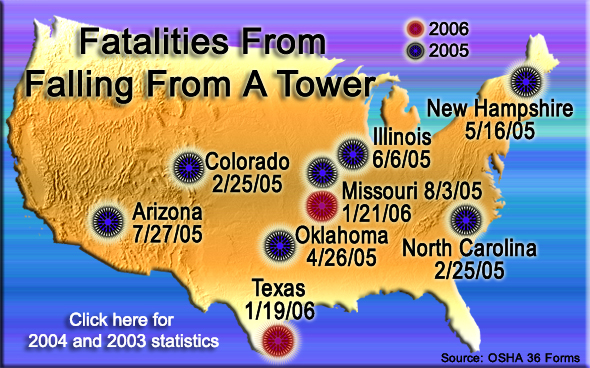
OSHA, the National Institute of Safety and Health, and the communications construction industry universally agree that there are too many fatalities every year from workers falling from telecommunications towers. There has always been disagreement regarding the methods the federal agencies use to gauge the industry's health.
"Recent OSHA statistics reflect a fatality rate of approximately 200 deaths per 100,000 workers which is closer to 30 times the normal fatality rate," Assistant Secretary of Labor John Henshaw stated, emphasizing the enormity of OSHA's concern about tower climber fatalities to members of the National Association of Tower Erectors at their annual conference in 2003.
OSHA officials have recently said that they could not identify where Assistant Secretary Henshaw had obtained his statistics for comparative purposes. The OSHA chief administrator resigned the following year.
Warnings were warranted, but not accurate
Guesstimates have been commonly used throughout the years since there were no accurate numbers available as to the number of climbers nationally as well as tower climber deaths. NIOSH had previously stated that the tower climber fatality rate could exceed the normal industry rate as much as 100 times which would place climber deaths at 430 per 100,000 employees in 2004.
WirelessEstimator.com solved part of the assessment problem by being able to present a more accurate picture of the number of climbers nationally following an extensive survey that identified "for hire" climbers at 8,700 throughout the country.
OSHA's Jocko Vermillion, a Cleveland, Ohio, compliance and safety officer, was able to piece together the number of fatalities that involved tower climbers, an arduous task since the tower construction industry does not have its own Standard Industrial Classification code.
After perusing the many thousands of OSHA 36 forms - a pre-inspection form used to record data pertaining to a fatality which is completed at the time the event is initially reported to the agency - Vermillion was able to compile a more representative number of deaths in the telecommunications construction and maintenance industry.
Vermillion's research was further complicated because each OSHA office will oftentimes identify a SIC code that is not closely represented to the profession or one of the industrial subcategories.
|
SIC Code assigned to tower-related fatalities in 2004:
|
|
Amount:
|
SIC Code:
|
SIC Code Description:
|
|
2
|
1623
|
Water, Sewer, Pipeline, and Communications and Power Line Construction
|
|
1
|
1629
|
Heavy Construction, Not Elsewhere Classified
|
|
1
|
1731
|
Electrical Work
|
|
2
|
1799
|
Special Trade Contractors
|
|
1
|
3441
|
Fabricated Structural Metal
|
|
1
|
3663
|
Radio and Television Broadcasting and Communications Equipment
|
|
1
|
4812
|
Radio Telephone Communications
|
|
1
|
4832
|
Radio Broadcasting Stations
|
None of the ten fatalities in 2004 were classified under structural iron and steel workers, but placed in categories such as electrical work and special trade contractors.
Drop in fatality rate attributed to interventions
In reference to WirelessEstimator.com's industry analysis, Cleveland OSHA Director Rob Medlock said, "We really appreciate your exhaustive research and expanded statistics on tower fatalities and employee information. This is the first time we have received statistically credible data on the number of tower workers."
Medlock also noted that the data validates OSHA's findings with regard to the high fatality rates among tower workers, and they are pleased with the industry's improvement. "I believe the important trend to consider is that all the data shows a trend of decreasing fatalities over the last few years. I attribute this positive trend to the added focus on safety and health in the tower industry and increased oversight that has progressed over the past several years," he commented.
Medlock believes that through such interventions as OSHA's partnership with the National Association of Tower Erectors, they have been able to work more closely with the industry in providing training specifically developed for tower erectors. He stated that many safety related programs have been developed and widely distributed through various forums.
"Personally, I have never worked with an industry that has responded as well to the challenge as the tower industry; to think where they were ten years ago in comparison to today is remarkable. Nevertheless, we have a long way to go and there are still some bad actors out there that need to be addressed," Medlock explained.
Upon reviewing the most recent information identifying the industry's fatality ranking, Patrick Howey, Executive Director of NATE, said, "I am very pleased to see that research shows safety in the tower industry is improving. The tower erection, service and maintenance industry has come a long way in the last decade. Best practices for safety have been defined, and accompanying safety resources have been developed to address those aspects of working on towers where accidents happen. Everyone involved in that effort should be proud of what has been accomplished. At the same time, recent events in the industry are a sad reminder that we still have work to do."
"Tie or Die!" is daily mantra of most climbers
The majority of fatalities are the result of climbers not being tied off to a safe anchorage point at all times or relying upon faulty personal protection equipment. In addition, many deaths occurred during the erection, retrofitting or dismantling of a tower. "Tie or Die!" has become synonymous with the requirement for 100% fall protection. During the past ten years as the industry matured, it has been accepted as a common work practice among the majority of tower workers, although many will admittedly ignore the requirement when climbing or working in areas where they believe it is practical and expedient to do so. January's two deaths were attributed to dismantling errors and unacceptable safety practices on the ground that resulted in the climbers' deaths, not necessarily climber error.
WirelessEstimator.com's survey identified approximately 8,700 climbers nationwide. More than seven hundred companies responded to an online survey. In addition, phone interviews were conducted and national vendor lists were used to identify additional companies with "for hire" climbers. Business directories were also searched to identify companies with climbers. Management from established tower companies also assisted in identifying other businesses that were in their state.
Three contractors employ 10% of "for hire" climbers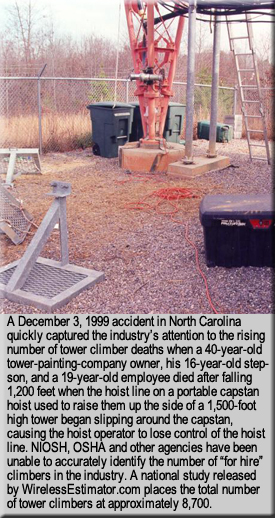
A total of 1,477 companies that employ "for hire" climbers were identified. Three of the country's largest telecommunications contractors, WesTower Communications, Andrew Systems, Inc. and Becon Construction Company, Inc., employ approximately 10% of the nation's climbers.
Five companies maintain an average of 125 climbers, but then the tower climbers per company are greatly reduced. A handful of companies employ approximately 40 climbers, but the majority of the nation's tower erection and maintenance businesses are staffed with six climbers or less.
Many companies with global sounding names employed less than three climbers. Some key telecommunications contractors identified that they subcontract all of their work and a considerable amount of companies had only one employee/owner who climbed. These firms typically offered sweep testing services and lighting system repairs.
It has been recognized that the industry had the most climbers during 2001, but capital budget cuts and a telecommunications industry downturn saw many large and small tower construction companies either reduce their workforce or close their doors. However, with increased tower builds and the urgency to deploy universal mobile telecommunications systems (UMTS), a service that lets users access corporate networks and the internet at high speeds over mobile phones, personal digital assistants, and laptop computers, tower climbers are again in high demand.
The top three companies are expecting to add almost three hundred climbers to their ranks this year and, nationwide, hundreds of tower companies are expecting to increase their climber count as well. Many companies will hire apprentice help, but most firms require experienced technicians.
During January, Becon Construction Company, a subsidiary of Bechtel Group, Inc., hired seventy climbers, but it did not swell the nation's climber count. According to Industrial Relations Manager De'Ann Eubanks, 66 of their new employees were experienced climbers and were recently employed with other tower construction companies.
Stealth climbers not visible in count
It is difficult to identify how many climbers there are in municipal, state and federal agencies. The South Carolina Educational Television Network, a state agency, employs six personnel to maintain their more than 600 towers, ranging in height from 80' to 550'. They are just one of many public radio and television organizations that have employees who climb on a routine basis.
"Many of these climbers are government employees in the communications department of federal, state and local governments, and climb depending on the budget constraints, personal preferences and patience. Usually their management either doesn't want to know, or avoids asking, whether they are climbing towers," noted Winton Wilcox, Jr., President of ComTrain, LLD.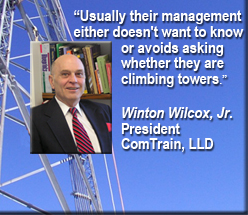
During the past ten years Wilcox's training organization has taught tower climbing safety and rescue to more than 20,000 students. He believes there is a greater universe of what he describes as "closet climbers".
"These closet climbers include employees of utility companies, transportation companies, and any corporate group that has multiple locations and internally controlled wireless communication. We have discovered dozens of these groups," Wilcox said, stating that on occasion some of these climbers' services could be for hire.
During 2004 and 2005, all 17 deaths were employees of "for hire" tower construction and maintenance companies.
Wilcox questions sole reliance upon deaths per 100,000 climbers to provide a safety checkup for the telecommunications construction and maintenance community. He points out that with such a small number of climbers that one climber death in the tower erectors' high risk industry would indicate an additional 11.5 deaths per 100,000 tower riggers, whereas an additional fatality in the structural iron and steel workers group would only add 1.5 deaths per 100,000 employees.
"I am hopeful that the results of WirelessEstimator.com's survey and analysis will generate additional, accurate information and guidance in improving, implementing and measuring safe practices for tower riggers," Wilcox said.
Noting the incorrect SIC codes for climber fatalities, William Vance, President of Communications Industry Training and Certification Academy, is equally as concerned about how fatality data is collected and assessed by the U.S. Department of Labor's Bureau of Statistics.
His apprehension about inconsistencies may be valid. The BLS identifies that the structural iron and steel workers' industry deaths per 100,000 employees was based upon the group having approximately 67,000 workers during 2004. For 2000's fatality count they based their fatality rate upon 79,000 workers for "structural metal work".
Contractor pricing squeeze complicates problem
Patrick Shea, of Arthur J. Gallagher, who tracks accidents and loss payments for the tower construction industry, believes that tower erection and maintenance is a very small niche of the steel erection industry and while he says the study appears to be accurate, it should not be compared to the broader industries as it skews the fatality rate. “One would have to take these other industries and carve out the more dangerous niches in each of them and then compare the fatality rate,” Shea commented.
“Lack of regulation and the fight for lowest price by telecom companies,” Shea insists, “keeps the unqualified tower company in business and will keep the fatality level high. Until these practices cease or are severely limited, the tower industry will continue to be one of the most dangerous professions in the U.S."
Shea manages the National Association of Tower Erector's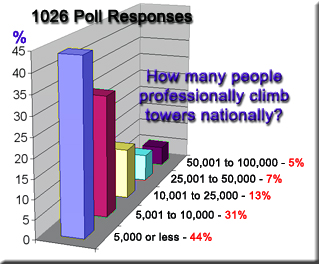 insurance program that is underwritten by AIG. insurance program that is underwritten by AIG.
According to the BLS, a total of 5,703 employees died in 2004 from workplace accidents. The fatality rate for all workers averaged 4.3 deaths per 100,000.
A total of 1026 respondents answered a poll on WirelessEstimator.com asking how many people professionally climbed towers nationally. Thirty one percent correctly identified that the number was between 5,000 and 10,000; 44% believed it was 5,000 or less.
Copyright © Wireless Estimator, Inc. Please request reprint permission.
|